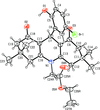issue contents
April 2017 issue

Cover illustration: The molecule of the compound N2,N2,N6,N6-tetraphenylpyridine-2,6-diamine has an unsymmetrical structure, although it can possess Cs symmetry. In the crystal, C-H N interactions between the phenyl and pyridyl rings lead to a molecular array along the b axis and C-H
N interactions between the phenyl and pyridyl rings lead to a molecular array along the b axis and C-H
![[pi]](/logos/entities/pi_rmgif.gif) interactions are also observed. These interactions are thought to be one of the reasons for lowering molecular symmetry. See: Miki, Umezono & Okuno [IUCrData (2017). 2, x170521].
interactions are also observed. These interactions are thought to be one of the reasons for lowering molecular symmetry. See: Miki, Umezono & Okuno [IUCrData (2017). 2, x170521].
metal-organic compounds


 access
access

 access
accessorganic compounds


 access
access

 access
access

 access
access

 access
access

 access
access

 access
access

 access
access

 access
access

 access
access

 access
access

 access
access

 access
access

 access
access

 access
access

 access
access

 access
access

 access
access

 access
access

 access
access

 access
access

 access
access

 access
access

 access
access

 access
access

 access
access

 access
access

 access
access

 journal menu
journal menu








































![[publCIF]](/logos/authorchecklist11.gif)





